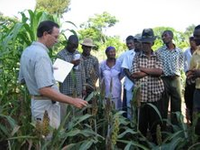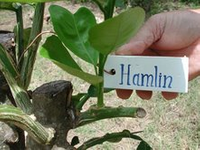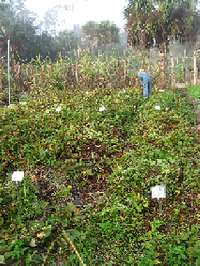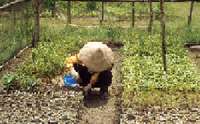During the course of each year a number of individuals working in community development spend some days studying and planning at ECHO. In reality their felt need is not so much for a bit more knowledge (study), but for a project plan for how they are going to proceed to help local farmers.

Farm field day showing farmers new crop varieties, SFRC, Haiti (Photo: ECHO staff)
A number of such visitors have told me that the single most helpful thing I shared with them during their visit is the concept of the Small Farm Resource Center. The central idea is that development organizations wishing to develop projects to do with the production side of agriculture have little choice but to do their own experimentation. Although many might wish it were so, no expert can come into your community and confidently tell you what new crop or technique you can successfully use or grow. Such an expert can suggest many things to try, but seldom can one safely begin talking farmers into adopting them tomorrow. (Thankfully there are agriculture-related projects that work in any climate and serve as initial projects while varieties and production techniques are screened and adapted. Examples would be veterinary work, post-harvest handling and processing, or appropriate technology-based projects.)
Many rural development organizations with projects in medicine, public health, education, water, sanitation, etc. hesitate to add agricultural projects—even though they see a need.
The reason, I suspect, is that it is less clear what they should do to have a major impact in agriculture than it is in other areas of emphasis. For example, medical projects can easily be initiated because, if someone is sick, a medical doctor will probably know what to do. But if the community is "sick" because of poverty of farmers, it is much less clear what should be done.
The bottom line of everything ECHO does comes down to this very point: How can we help you devise a project plan that will make a significant difference in the lives of peasant farmers?
The Need
There are several requirements for a satisfactory project in production agriculture. The idea must (1) involve no risk to local farmers, (2) be something they are not already doing, (3) make such a major difference that farmers will readily adapt the innovation and (4) have a ready market if it involves sale of a product or local acceptance if it is to be used by the farmer him/herself.
I have often heard development workers say something like, "I have no need for additional technical information. What I need is more insight on how to get these backward farmers to act on what I already have to offer." Perhaps. But more likely the problem is that the ideas they have are not nearly good enough.
Although there may be few if any ideas which a mission can be certain will meet all four criteria, there is hope. It is just that there is a step between getting an idea and beginning the extension work. Many things have the potential to be as successful in the community as they have been elsewhere in the world. They just need to be screened and fine-tuned under local conditions and on local farms.
Two principles lie behind my conviction that the Small Farm Resource Development Project (SFRDP) is the way I would do agricultural missions. (1) I have great optimism that there are resources in God's creation that will bless any community in which I might be called to work. (2) I bring a sense of humility as to whether I know which ones it will be until/unless I have an opportunity to do adaptive research.
(I should mention that ready-to-go agriculture projects do exist, especially in the veterinarian field, where much universally applicable knowledge is available, and appropriate technology. If chickens are dying of Newcastle's disease, for example, a vaccination program could immediately be useful. A design for a grain storage bin that worked in Honduras would probably also work in Nicaragua. Exceptions would also be found if the organization were to come across an innovation that had already been proven in the community, but the extension work had not yet been done. But be careful. I saw one such project where a local group had proven that pineapples would thrive. Several private and government pineapple projects soon sprung up. You guessed it – within two years pineapples were so cheap they were hardly worth harvesting. The average development project gives far too little emphasis to marketing studies and projections.)
The Small Farm Resource Development Project
Both your supporters at home and the farmers you serve have high expectations of you. They are going to look for great (and near-term) success in whatever you try, and you will loose credibility quickly if you begin projects that fail—unless everyone knows up front that you are first going to be doing experimental trials.
Much of the pressure is eliminated if you say something like the following. "Everyone knows that a lot of new ideas outsiders bring in are worthless. But there are a lot of things that have brought an improved life to farmers similar to you in other parts of the world. I'm going to be trying several of those things. Most of them probably will not be worth much. But probably one or a few will be something that you might be interested in."
"I invite you to watch the progress of things that we will be trying here at the Small Farm Resource Center (SFRC). When we sort out which ones seem to be really interesting, you can help us by doing a very small trial on your own farm."
The purpose of the SFRC is to evaluate within the community ideas that have been proven elsewhere. The most promising ideas are adapted to become the backbone of the agricultural outreach. This adaptive research, as it is called, is done directly by the non-government agency (NGO) and local farmers.
We use two slightly different names, one for the project itself and one for the piece of land where initial trials are done. The Small Farm Resource Center (SFRC) coordinates trials on a central site as well as on fields of individual farmers. Any new ideas, techniques, crops or new varieties of a local crop, are first evaluated at the SFRC. The Small Farm Resource Development Project (SFRDP) tests the most promising results through on‑farm trials in the community. Unforeseen problems and possibly farmer-devised solutions may arise as trials are done under field conditions and sometimes in different microclimates. An important side benefit is that local farmers are learning to do their own testing of new ideas. Marketing studies may also be done.
The Outcome
The overall goal of the SFRDP is to take local agriculture a step beyond the already considerable indigenous knowledge. With rare exceptions the SFRDP is not needed if the goal is just to produce food. Specific long-term goals might include (1) finding new sources of income, food and employment, (2) improving the profitability and reliability of present farming operations, (3) backing these up with marketing studies and market development activities, (4) improving both economic security and nutritional balance by including a greater diversity of crops, (6) reducing vulnerability to global economic swings by minimizing the need for imported items in operation of the farm, and (7) reversal of ecological problems caused by erosion and deforestation.
The SFRC has two distinct functions. One, the experimental component is to test and adapt new ideas which have potential to aid in the development of the community. This is not the kind of research that is done at universities, but rather adaptive experiments to make sure what has worked elsewhere can be reliably expected to work in this particular community. The other, the demonstration and training component, is to use the center and on-farm trials as a teaching tool. It can be a base from which promising results are shown to both future extension staff of the sponsoring organization and to other interested government officials, development groups or farmers in the community.
Where Trials Should Be Done

Experimenting and demonstrating citrus improvement at a SFRC, Haiti. (Photo: Tim Motis)
Trials should be carried out both at a central SFRC site and by local farmers on their own land. Each has its strengths and limitations.
SFRC Trials. It will be important to have a central focal point for visibility, locally, with the government, and with the diverse groups in the country who might wish to learn from the SFRC. It is also necessary to have a central location where a preliminary screening of new ideas can take place.
Experiments that may have less likelihood of success should only be done at the central SFRC site initially until such time as they are shown to have definite promise.
On-Farm Trials. Before Tom Post (see “A Real Life Example” below) had an opportunity to establish a SFRDP, on-farm trials were already underway. It seemed like a great idea. The government research station had identified onions as a profitable cash crop recently imported into the country. They had also selected varieties and developed cultural practices. But unknown to anyone, there was a disease in that particular part of Belize that ruined the onions. If the SFRC had been in existence, the first trials would have been done at the Center and farmers would not have had such a visible initial discouragement.
The on‑farm trials are economically more efficient, are more representative of the diverse micro-climates, soil types, etc., increase visibility in the community, help farmers learn the experimental approach, give them a sense of ownership in the project, and greatly reduce the likelihood of poor choices for subsequent introductions. Once a success is proven in on-farm trials, much of the extension work is already done. On‑farm experiments will always be on a small scale so that the risk to any farmer is minor.
Project Global Village in Honduras wondered if subtropical apples might be a basis for a development project at a remote site high in the mountains. We helped them bring in 1,000 apple trees, which were evaluated entirely with on-farm trials. I believe they were distributed to a couple hundred farmers. The last we had heard in the late 1990’s was that there were then over 200,000 trees in the ground. No one knows for sure how many today, because farmers now graft and sell their own trees.
A Real-Life Example
In the mid 1980's ECHO suggested to Tom Post, country director for the Christian Reformed World Relief Committee (CRWRC) in Belize, that they establish a SFRC in a small community there. Tom shared the following observations on the value of the project.
- “It provides a place to try crops on our own land that will not hurt the farmers if the crops should fail. We had begun our work directly with farmers before we had the SFRC. Due to initial failures we dropped from 30 interested farmers to 3 the first year. Now negative results are just part of the expected outcomes of any large number of trials at the Center. For example, we failed to make money on an egg project that had originally looked good, but found that farmers could make money on broilers. A combined solar and wood burning grain dryer that we built turned out to have a design flaw and burned down -- but it only involved the SFRC.
- “Even though we have degrees in tropical agriculture and years experience, we need self-confidence and confidence in what we are about to promote. The same applies to the local extension staff. The SFRC allows us to convince ourselves that what we are recommending really works.
- “It serves as a point of contact between our organization and Belizean institutions (other voluntary organizations, governmental ministries and agricultural research agencies. It gives our small group much more visibility and a "location" where we have a large sign by the highway, "Small Farm Resource Center." Visitors can see and recognize quality work. We also are now seeing other groups picking up on some of our results. One has ordered 4,000 pounds each of velvet bean and jack bean seed.
- “It is a valuable investment in the future. Development organizations tend to go for quick term results, using only ideas that are known to have a high probability of success. A result is that we do not consider other options. At the SFRC we can try things that, for lack of experience, leave us less certain of success but hold a great deal of promise. Use of the moringa tree was in that category, now it is looking more and more like a "sure bet" for our projects.
- “It provides a valuable hands-on opportunity for North American supporters to be involved in ways that go beyond just giving donations. Donors feel an increasing need to know for themselves the benefit of their help. If work teams do projects in the village, they may be doing things that the local people can do for themselves [and resentment can result.] But projects done at the SFRC will not disrupt village life and will be a genuine help to our work. North Americans can try out their skills without doing harm by their trial and error learning."
From my reading before actually working in development, I had the impression that farmers were so resistant to change that they would certainly not be interested in doing experiments. I have been pleasantly surprised from reports in our network at how eager farmers are to do experiments – if they have confidence that some of them are worthwhile. Tom took me to visit some participating farmers in Belize. Each farmer had a particular experiment he was doing. One eagerly showed us a couple others he had come up with on his own.
Special Benefits

Sweet potato variety trial (Photo: ECHO staff)
For farmers or institutions that have an abundance of fertile, well‑watered land and considerable capital for its exploitation, there may be no need to search for new ways of generating income and growing food. But for those forced to farm under difficult, marginal conditions, with meager resources on a small amount of land, the need is obvious. In the case in Belize, the need to diversify from reliance on sugar cane was a prime concern.
No attempt is made to develop an expensive infrastructure. No commitment is made to multi‑year funding. The SFRC can be continued as long as its results are a clear benefit (or until so many good, proven ideas are available that the extension staff has all it can use) and can be discontinued at any time with minimal waste of funds.
Although we had discussed with Project Global Village the possibility of starting a SFRC, the apple project ended up having so much potential that all efforts went into its development. Always keep in mind that the SFRC is there to benefit farmers, not to conduct research as an end in itself. If you invest little in infrastructure, efforts can be rechanneled at any time without waste.
Further Possibilities
(1) Once a set of workable technologies has been proven effective, the sponsoring organization might wish to set up a demonstration area at the SFRC to use in training. I do not call the SFRC a "demonstration farm" because that concept has not worked in all situations and cultures. The SFRC is a place where trials are done, and assumes the added role of a demonstration farm only if that approach seems suited to the local situation. Site visits to on-farm trials may be preferable in some situations because people can often identify more closely with projects done by their peers. On the other hand, logistics of travel and instruction are simpler if many things can be demonstrated at a central site.
(2) If an agricultural college or training center is nearby, many opportunities for collaboration will exist. Students benefit by gaining hands-on experience in a very applied kind of research. The SFRC benefits by being able to do many more experiments using free student labor.
(3) Increasingly donors want to see and experience the work first-hand. Although a missions study tour has advantages over a "work team," in my opinion, many feel obligated to work with their hands to justify the expense of the trip. So "work teams" have become increasingly popular. Having them work on projects in the village which villagers can easily do themselves can foster resentment. Projects can usually be found on the SFRC to provide a rewarding experience for the volunteers, which benefit the project, and which avoid misunderstandings within the community. At the same time they can work with and get to know the local people and culture and worship with them.
(4) Many North American colleges send their students overseas for a few months of exposure to conditions and cultures of developing countries, but it is often difficult to find assignments for which they are qualified. Poor command of a language and lack of fully developed cultural sensitivity normally limit the effectiveness of such short term persons. They often return disillusioned because they could not do much of significance. However, the student working primarily with the experimental phase of a SFRC program could begin making a useful contribution the day after his/her arrival! Students would come to work under the supervision of the SFRC staff, not to directly introduce change into the society.
I would anticipate that some colleges would welcome opportunities for a few of their students to spend a summer, semester or year with a project (as long as it was staffed with a long‑term director with at least a B.S. degree).
(5) Periodically a professor looking for a sabbatical opportunity calls to explore whether he/she might do something in the area of world hunger. Some of them could help by carrying out trials, adapting integrated pest management (IPM) techniques to the local area, etc.
What Trials should be Done?

Demonstration coffee nursery, Viet Nam (Photo: Larry Yarger)
The raising of crops and livestock is probably the major agricultural concern of most small Third World farmers. So the SFRC will probably concentrate on finding new crops or improved varieties of presently cultivated crops, improving productivity, better techniques for cultivation of crops that will not require cash (and foreign exchange) for purchase of pesticides and fertilizers, and grain storage. The farm is, of course, free to use a mix of organic and chemical methods depending on your philosophy and the local situation. Other
emphases might include agroforestry, animal husbandry and aquaculture, growing livestock feed/forage and post-harvest storage and handling.
Growing for export markets is very risky for the typical, relatively small, organization in ECHO's network. Don't even think of exporting unless a large, proven organization is already doing it and your farmers are just plugging into their program. Even then, one fruit fly scare or United Nations embargo can bring disaster.
Appropriate technologies may be chosen for the demonstration part of the farm. Chances are there are so many good designs already that what is needed is someone with perspective to pick the one or two best suited and go with them, rather than making new designs. The benefit of appropriate technologies is that what works in one climate and latitude will normally work about anywhere. Sometimes there are pleasant surprises. Three organizations that built self-composting toilets for their staff soon after starting the project in Central America (Guatemala and Honduras) told me that they generated intense interest in the community.
Taking the Long View
Development projects seem to proceed in units of a few years, but communities develop over long periods. Trials should be directed at both short‑ and long‑term needs of the community. Some ideas should be selected with the anticipation that in the very near term (less than a year) they will be ready to go. (An unfortunate side effect of the short-term nature of most projects, especially funding for them, is that only ideas with near-term payoff get serious attention.) Some trials that will not be completed for years should be started right away so they can begin growing, e.g. evaluation of fruit tree varieties.
What ECHO Can Offer
ECHO is committed to the principal of working directly in the developing community only in conjunction with other organizations that already have projects under way in that particular country. We wish to help those organizations grow and succeed, benefiting from ECHO's input but becoming less and less dependent on it. These organizations provide the in‑depth understanding of the needs and unique problems of the people in the country. They are the ones to introduce new opportunities into the communities by incorporating them into their own development projects.
It is surprising how often I hear from someone considering a SFRC whose main goal is to grow food for a school or orphanage. You probably do not need a SFRC. Are there local farmers who grow food? If so, hire some of them to produce the food for your institution, teach your students etc. Remember that the SFRC is at its core an approach to doing research.
ECHO’s quarterly technical bulletin, Echo Development Notes (EDN), is sent to thousands of development workers in over 180 countries, including distribution by the Peace Corps to Peace Corps volunteers and by USAID to each of their agricultural officers. Through ECHO’s seed bank we distribute sample packets of well over 600 accessions of seed to development practitioners worldwide. These consist primarily of crop and tree species useful as food, forage and fuelin difficult areas of the world. Specially adapted varieties of more common crops are also included.
ECHO is in a unique position to provide ideas, information and packets of seed for trials on the SFRC. EDN provides ideas from which to choose initial areas for trials. The first 15 years of EDN are available in an updated and reorganized book, Amaranth to Zai Holes: ideas for growing food under difficult conditions. A backset of EDN issues since that time can be purchased at ECHO. Amaranth to Zai Holes is also available through our on-line bookstore as well as an interactive read on the website. EDN, along with other valuable information is available on our web site in English, Spanish and French.
ECHO is a non‑profit, Christian resource organization whose primary purpose is to provide technical support to various groups and individuals working with problems of the small farmer and small farm production in the developing world. Our basic approach is to help these other development groups to be more effective. (We are not equipped as a financial organization to provide money, agricultural supplies or help in locating money.)
Our numerous collaborators in ECHO’s overseas network have demonstrated a great eagerness for experimenting with new seeds and ideas that are mentioned in EDN. Hundreds of trial seed packets have been sent. Numerous technical questions have been received and answered. An active network of scientists and of development workers with daily on‑the‑farm contacts forms a rich resource for input of new ideas and approaches, most of which have been already filtered for appropriateness to at least a portion of the developing world.
The most helpful things that are learned from the experiments or from local farmers or other organizations we share with our network via ECHO Development Notes. This completes the cycle that began with many ideas originally coming from these same folks. Our ability to spread results to many other countries by plugging information into the ECHO network adds an excitement and motivation to local participants as well. ECHO's ministry is based on sharing information. Consequently it cannot accept any restrictions that would limit this freedom. No results will be treated as proprietary.
Cite this article as:
Price, M.L. 1993. Small Farm Resource Development Project. ECHO Technical Note no. 29.